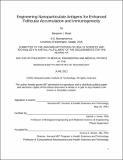Engineering Nanoparticulate Antigens for Enhanced Follicular Accumulation and Immunogenicity
Author(s)
Read, Benjamin J.
DownloadThesis PDF (2.166Mb)
Advisor
Irvine, Darrell J.
Terms of use
Metadata
Show full item recordAbstract
In vaccine design, antigens are often arrayed in a multivalent nanoparticle form, but in vivo mechanisms underlying the enhanced immunity elicited by such vaccines remain poorly understood. In this thesis, we began by examining two model, HIV-immunogen-bearing nanoparticles that displayed an unusually high degree of immunogenicity. We found that these nanoparticles accumulated selectively within the follicular dendritic cell network of draining lymph nodes, and discovered that this trafficking pattern was dependent on complement recognition mediated by mannose-binding lectin (MBL) binding to glycans on the surface of the nanoparticles. Accumulation within follicles was positively associated with multiple immune response outputs. Trafficking was found to occur in a variety of nanoparticles of different sizes and compositions, and the primary factor that allowed for trafficking to occur was the presence of high-mannose glycans on the surface of the nanoparticles. Several clinically-relevant nanoparticle antigens were also found to traffic in an MBL-dependent fashion, suggesting that this mechanism could be utilized to improve the efficacy of a variety of important nanoparticulate antigens. We also utilized DNA origami nanoparticles as a model system to probe critical parameters of nanoparticle vaccine design, including antigen density, antigen spacing, nanoparticle geometry, and overall antigen concentration. Initial in vivo studies are described, as are suggestions for future experiments to further the design and functionality of these particles for vaccination. Overall, these studies have elucidated a number of design principles that should aid in the engineering of next generation vaccines to provide protection against a variety of possible pathogens.
Date issued
2021-06Department
Harvard-MIT Program in Health Sciences and TechnologyPublisher
Massachusetts Institute of Technology